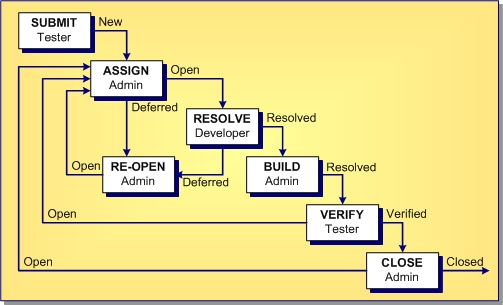Change Request Tracking System Model

The above diagram and steps show the change request tracking process. The boxes represent the steps taken from the time that the change request is submitted until the time it is closed. Each box indicates an action and the team member most likely to be responsible for performing this action. The arrows show the status of the change request at the time of each step.
The change request tracking system consists of the following steps:
- Step 1
-
A team member creates a new change request that does either of the following:
- Summarizes a problem with the product and lists the steps taken to reproduce the problem.
- Suggests an enhancement to the product.
This change request has a status of New.
- Step 2
-
Another person, such as an administrator or team leader, decides whether to fix the problem or add the suggested enhancement to the product. This person can:
- Set the status of the change request to Open, and assign a team member to resolve it.
- Set the status of the change request to Deferred because it is worthwhile but will not be done at this time.
- Set the status of the change request to Is Duplicate because this is not the first time it has been submitted. If desired, a link can be created between a change request and the original submission so that you can track the change request along with the original submission.
- Set the status of the change request to As Designed because the product is supposed to work this way, meaning there is no defect.
Change requests with an Open status go to step 3.
- Step 3
-
The person assigned to resolving the change request changes the status of the change request to In Progress. Later on, after this person finishes examining the change request, he or she changes the status to one of the following:
- Fixed
- Documented
- Cannot Reproduce
- Step 4
-
Next, a team member (usually a tester or quality assurance engineer) verifies the change request. For example, a test case may be developed to determine if the problem is really fixed, documented or not reproducible and changes the status to one of the following verified statuses:
- Verified As Designed
- Verified Cannot Reproduce
- Verified Documented
- Verified Fixed
- Verified Is Duplicate
- Step 5
-
Finally, another team member changes the status to Closed. This person may then perform activities related to closing the change request, such as retesting the change request before closing it or adding it to a report to be included in the next release of the product.
In most of the above steps, the change request can be reopened and reprocessed.